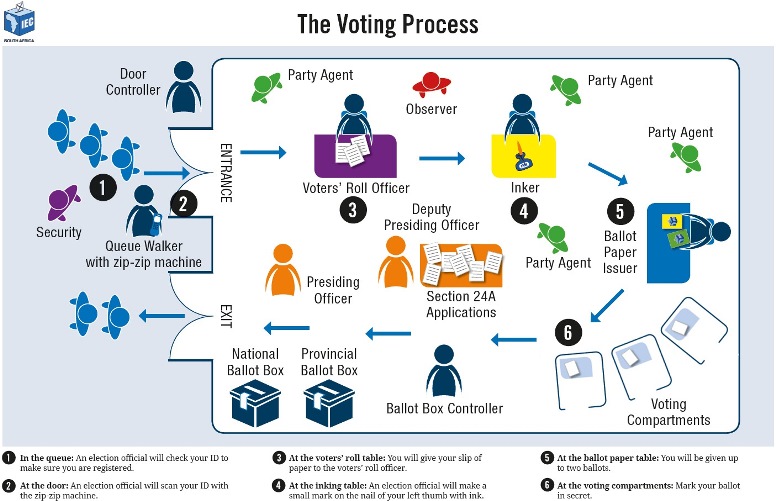What are the municipal elections?
Municipal elections take place every five years to elect councillors who will be responsible for running a municipality.These councillors will serve on the town, city, metropolitan or district councils where they will make sure that your areas receive services such as electricity, water and sewerage.
What’s this about there being three ballot papers?
The ballot papers that you will receive have different colours and depends on the type of municipality in which you are registered to vote.
In metropolitan councils (Joburg, Tshwane, eThekwini, Cape Town, Buffalo City, Ekurhuleni, Nelson Mandela Bay and Mangaung) there will be two ballot papers:
Yellow ballot paper for the metro council election: you will vote for a party of the proportional representation (PR) list
White ballot paper for the ward elections: you will vote for a person to represent the ward.
In local council areas (outside of metropolitan areas) there will be three ballot papers:
Yellow ballot paper for the local council election: you will vote for a party of the PR list
White ballot paper for the ward elections: you will vote for a person to represent the ward
Green ballot paper for the district council election: you will vote for a political party
So who gets to sit on the council?
In municipal elections, you vote for a political party AND a ward councillor (a mixed system of PR and a ward constituency system) to get seats at the municipal level.
In both local and metropolitan councils, half of the seats are given to the ward councillors (which you voted for on the white paper) and the other half are given to the political parties based on the results of the other papers.
What do I need to take to the voting station?
You need to show your green South African ID Book or a temporary identification certificate to the voting officer. This allows the voting officer to verify that you are registered to vote on the voters’ roll.
If you do not appear on the voters’ roll but have proof that you have registered, this must be validated by the presiding officer. You will then have to fill in a MEC7 form – which is basically a municipal elections form – and can proceed as an ordinary voter.

How does the actual voting process work?
Once your ID has been verified, your name will be checked off the voters’ roll. Your ID will be stamped on the second page and your thumb will be inked. This will indicate that you have already voted.
The voting officer will then stamp the back of the official ballot papers and hand them to you. You can take your ballot papers to one of the empty booths and mark the ballot papers with your votes. Once you have voted, fold the ballot paper and place it in the ballot box. And that’s it, your vote has been cast.
What if I make a mistake on the ballot sheet?
Any incorrectly marked votes are noted as “cancelled” by the presiding officer. You will then receive a new ballot paper and an opportunity to recast your vote. You can only receive new ballot paper if you realise your mistake before you place your ballot sheet in the ballot box.
When will the results come out?
By law, the results need to be announced within seven days of the elections. During the municipal elections, each ward and municipality has its own election, so the results should come out a few hours after the voting stations have been closed. The final, final results are expected to be announced on Wednesday, 10 August.

![IEC voting station [slider]](https://www.thedailyvox.co.za/wp-content/uploads/2016/04/IEC-voting-statiosn.jpg)








